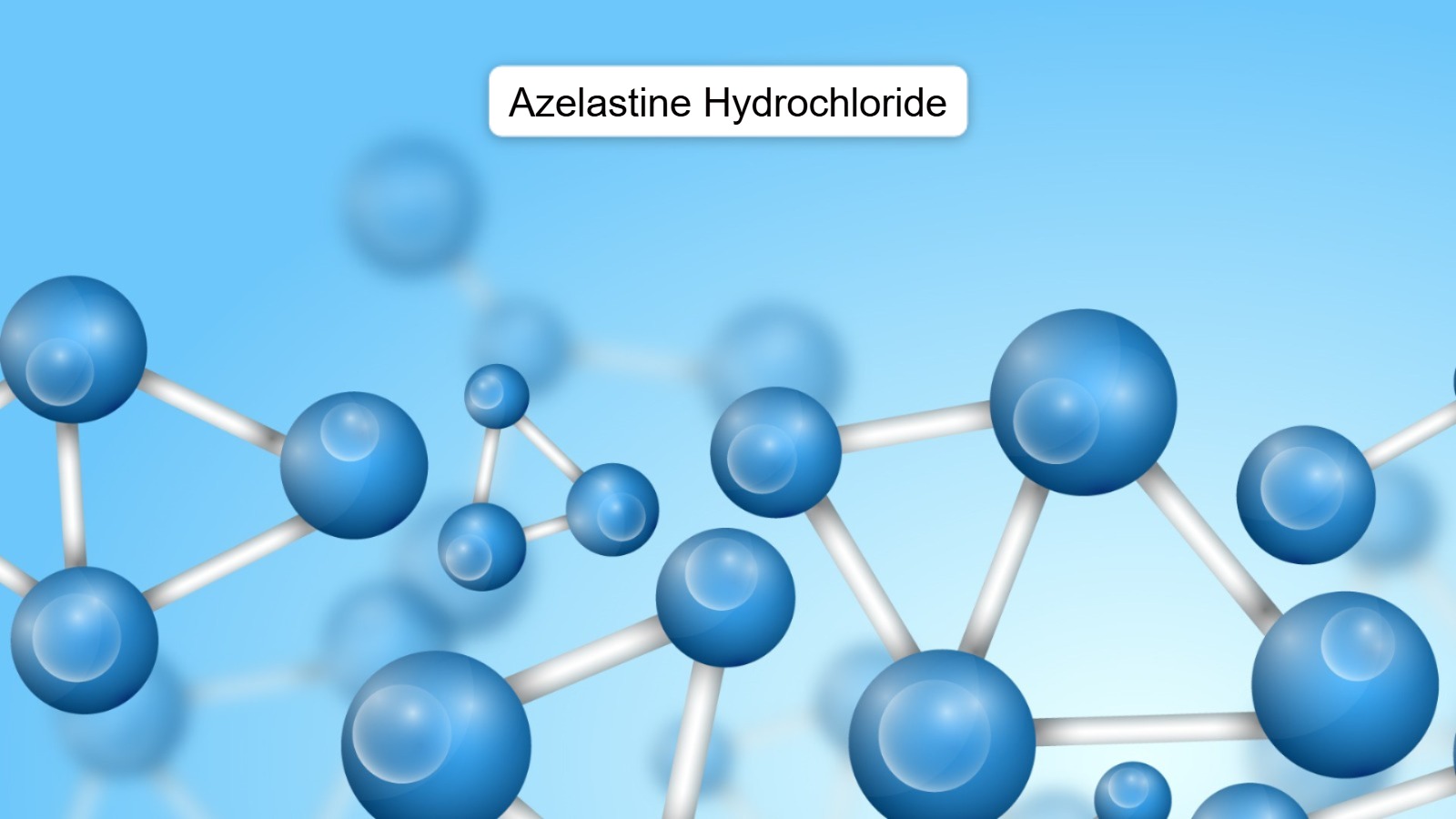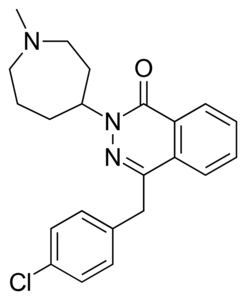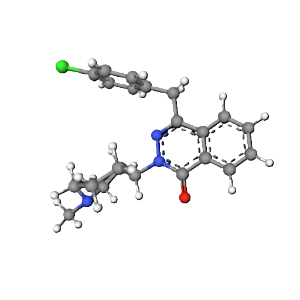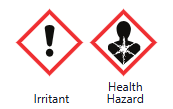
Azelastine Hydrochloride is a potent second-generation antihistamine widely used for managing allergic rhinitis and conjunctivitis. Its distinctive structure, chemical properties, and precise mechanism of action have made it an essential medication in allergy treatment. This detailed blog delves into the structure, properties, pharmacology, uses, and safety of Azelastine Hydrochloride.
1. Structure of Azelastine Hydrochloride
Understanding the molecular structure of Azelastine Hydrochloride helps explain its efficacy in allergy management.
2D Structure Azelastine Hydrochloride
The 2D structure of Azelastine Hydrochloride showcases its phthalazinone backbone, functionalized with benzyl and dimethylamino groups. These elements contribute to its high affinity for histamine H1 receptors, minimizing allergic reactions.

3D Structure Azelastine Hydrochloride
The 3D conformation of Azelastine Hydrochloride reveals its spatial geometry, emphasizing its receptor-binding capabilities. The molecule’s planar regions optimize interactions with H1 receptor sites, enhancing its antihistamine activity.

2. Names and Identifiers
Azelastine Hydrochloride is well-documented under various scientific names and identifiers.
- IUPAC Name: 1-(2H-benzimidazol-2-yl)-1-(4-chlorobenzyl)-2-(dimethylamino)propane hydrochloride
- Molecular Formula: C22H24ClN3O · HCl
- Molecular Weight: 418.37 g/mol
- CAS Registry Number: 79307-93-0
- Synonyms: Astelin, Astepro, Optivar
These identifiers make Azelastine Hydrochloride easily recognizable across scientific and medical communities.
3. Chemical and Physical Properties
The chemical and physical properties of Azelastine Hydrochloride contribute significantly to its pharmacological effectiveness.
| Property | Details |
|---|---|
| Appearance | White to off-white crystalline powder |
| Melting Point | ~225–230°C |
| Solubility | Soluble in water, ethanol, and methanol |
| LogP (Partition Coefficient) | ~2.6 |
| pKa | ~9.5 |
| Chemical Class | Phthalazinone derivative |
These properties enable its formulation into nasal sprays and ophthalmic solutions for targeted application.
Explore a leading manufacturer of APIs.
With over 10 years of expertise, we ensure GMP compliance and provide reliable, high-quality solutions.
4. Drug and Medication Information
Azelastine Hydrochloride is primarily used in treating allergic conditions through various formulations.
Formulations
- Nasal Sprays:
- 0.1% and 0.15% concentrations.
- Ophthalmic Solutions:
- 0.05% concentration.
Mechanism of Action
Azelastine Hydrochloride works by:
- Blocking H1 Receptors: Reduces histamine-induced inflammation and symptoms.
- Inhibiting Inflammatory Mediators: Prevents the release of leukotrienes and cytokines, offering dual-action relief.
Dosage and Administration
- For Allergic Rhinitis: 1-2 sprays per nostril twice daily.
- For Allergic Conjunctivitis: 1 drop in each affected eye twice daily.
Consult a healthcare professional for personalized dosage guidelines.
5. Pharmacology and Biochemistry
Azelastine Hydrochloride’s pharmacology is rooted in its antihistaminic and anti-inflammatory properties.
Pharmacokinetics
- Absorption: Rapid with intranasal and ophthalmic use.
- Bioavailability: ~40% via nasal administration.
- Half-Life: ~22 hours, allowing prolonged symptom relief.
- Metabolism: Liver metabolism via cytochrome P450 enzymes.
- Excretion: Primarily renal.
Pharmacodynamics
Azelastine Hydrochloride binds selectively to H1 receptors, stabilizing mast cells and reducing allergic inflammation. Its dual-action mechanism improves patient outcomes by addressing both immediate and delayed allergic symptoms.
6. Uses and Side Effects
Primary Uses
- Seasonal Allergic Rhinitis: Alleviates symptoms like sneezing, congestion, and postnasal drip.
- Allergic Conjunctivitis: Reduces redness, itching, and watering of the eyes.
- Non-Allergic Rhinitis: Manages chronic nasal irritation caused by non-allergic triggers.
Benefits
- Rapid onset of action (within 15 minutes).
- Long-lasting relief (up to 12 hours).
Side Effects
Azelastine Hydrochloride is generally well-tolerated. Common side effects include:
- Bitter taste in the mouth.
- Nasal dryness or irritation.
- Mild drowsiness.
Rare side effects may include severe allergic reactions such as swelling, rash, or difficulty breathing. Consult a healthcare provider if side effects persist.
7. Safety and Hazards
Safety Profile
Azelastine Hydrochloride is safe for most individuals when used as directed. However:
- Pregnancy and Breastfeeding: Use with caution; consult a physician.
- Children: Safe with age-appropriate dosage.
Handling Precautions
- Store in a cool, dry place, away from direct sunlight.
- Keep out of reach of children.
Chemical Safety

Environmental Impact
Azelastine Hydrochloride has minimal ecological risk due to its rapid degradation in aquatic systems.
Chemignition Laboratory is a globally trusted manufacturer and exporter of high-quality Azelastine Hydrochloride.
We specialize in APIs and provide complete documentation support including GMP Certificate, COA, MSDS, Stability Data, Impurity Profile, and ISO 9001 Certificate.
Customized packaging and cold chain logistics ensure safe delivery of sensitive APIs worldwide.
We proudly serve pharmaceutical companies across the USA, Europe, Asia, and more.
Partner with Chemignition Laboratory for consistent quality, regulatory compliance, and reliable global supply.
FAQs
IUPAC name of Azelastine Hydrochloride?
IUPAC name of Azelastine Hydrochloride is 1-(2H-benzimidazol-2-yl)-1-(4-chlorobenzyl)-2-(dimethylamino)propane hydrochloride.
Molecular Formula of Azelastine Hydrochloride?
Molecular Formula of Azelastine Hydrochloride is C22H24ClN3O.HCl.
Molecular Weight of Azelastine Hydrochloride?
Molecular Weight of Azelastine Hydrochloride is 418.37 g/mol.
CAS No. of Azelastine Hydrochloride?
Azelastine Hydrochloride CAS No. :79307-93-0
How long does it take for Azelastine Hydrochloride to work?
Relief begins within 15 minutes of use for nasal spray and eye drops.
Can I use Azelastine Hydrochloride during pregnancy?
It is classified as Category C. Consult your doctor before use.
Is Azelastine Hydrochloride safe for children?
Yes, but dosage varies by age. Always follow pediatrician recommendations.
What is Azelastine Hydrochloride used for?
Azelastine Hydrochloride is used to treat symptoms of allergic rhinitis (sneezing, runny nose, congestion) and allergic conjunctivitis (itchy, red, watery eyes). It is also effective for managing non-allergic rhinitis.
How does Azelastine Hydrochloride work?
Azelastine Hydrochloride works by blocking H1 histamine receptors, reducing the effects of histamine in the body. This action helps alleviate allergic symptoms like inflammation, sneezing, and nasal congestion.
What are the common side effects of Azelastine Hydrochloride?
Common side effects include:</p>
- Bitter taste i
n the mouth.
- Mild nasal dryness or irritation.
- Drowsiness or fatigue.
- Burning or stinging sensation in the eyes (for ophthalmic solutions).
How should Azelastine Hydrochloride be used?
Nasal Spray: 1-2 sprays per nostril twice daily or as directed by a doctor.
Eye Drops: 1 drop in the affected eye(s) twice daily or as directed. Always follow your doctor’s instructions and avoid overuse.
